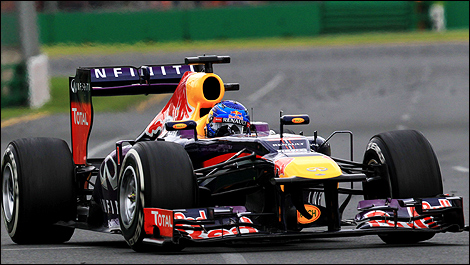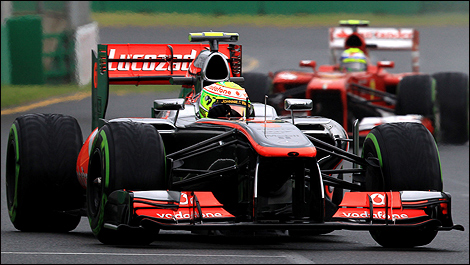Mar
19th
Stay connected Subscribe to our RSS feed
Sebastian Vettel's and Mark Webber's Red Bull RB9 Renaults ran very thin rear wings during the Australian Grand Prix last weekend in Melbourne.
As seen in these photos, the main wing plane and the flap of the rear wing of the RB9s were significantly thinner than those of rivals McLaren and Ferrari.
This is quite surprising because Melbourne, a temporary street circuit, normally requires quite a bit of downforce.
Running such a big rear wing as the McLaren requires a lot of top end power from the Mercedes V8, because a wing not only produces downforce but also drag, which slows the car down on the straights.
We can only assume that McLaren had to run their MP4-28s in this high-downforce configuration because they couldn't get the new Pirelli tires to their correct working temperature.
This significant difference also showed in terms of top speed at various portions of the circuit.
In qualifying, both Red Bulls were, on average, 5-7 km/h faster than the McLarens on the straights. The Ferraris of Fernando Alonso and Felipe Massa were amongst the quickest of all.
It was roughly the same during the race with Button, constantly the slowest. At the main speed trap, Button's McLaren was 6 km/h slower than Vettel's Red Bull. Jean-Eric Vergne's Ferrari-powered Toro Rosso was the quickest of all at 310.7 km/h, followed by Alonso.
We can conclude that -- like its predecessors -- the Red Bull RB9 generates a lot of downforce from his floor and diffuser. Therefore, the team can run its cars with thinner wings which allow better top speeds.
As seen in these photos, the main wing plane and the flap of the rear wing of the RB9s were significantly thinner than those of rivals McLaren and Ferrari.
This is quite surprising because Melbourne, a temporary street circuit, normally requires quite a bit of downforce.
Running such a big rear wing as the McLaren requires a lot of top end power from the Mercedes V8, because a wing not only produces downforce but also drag, which slows the car down on the straights.
We can only assume that McLaren had to run their MP4-28s in this high-downforce configuration because they couldn't get the new Pirelli tires to their correct working temperature.
 |
| Red Bull-Renault RB9. (Photo: WRi2) |
 |
| McLaren MP4-28-Mercedes. (Photo: WRi2) |
This significant difference also showed in terms of top speed at various portions of the circuit.
In qualifying, both Red Bulls were, on average, 5-7 km/h faster than the McLarens on the straights. The Ferraris of Fernando Alonso and Felipe Massa were amongst the quickest of all.
It was roughly the same during the race with Button, constantly the slowest. At the main speed trap, Button's McLaren was 6 km/h slower than Vettel's Red Bull. Jean-Eric Vergne's Ferrari-powered Toro Rosso was the quickest of all at 310.7 km/h, followed by Alonso.
We can conclude that -- like its predecessors -- the Red Bull RB9 generates a lot of downforce from his floor and diffuser. Therefore, the team can run its cars with thinner wings which allow better top speeds.
 The latest auto news, reviews, prices, product and vehicle releases.
The latest auto news, reviews, prices, product and vehicle releases.